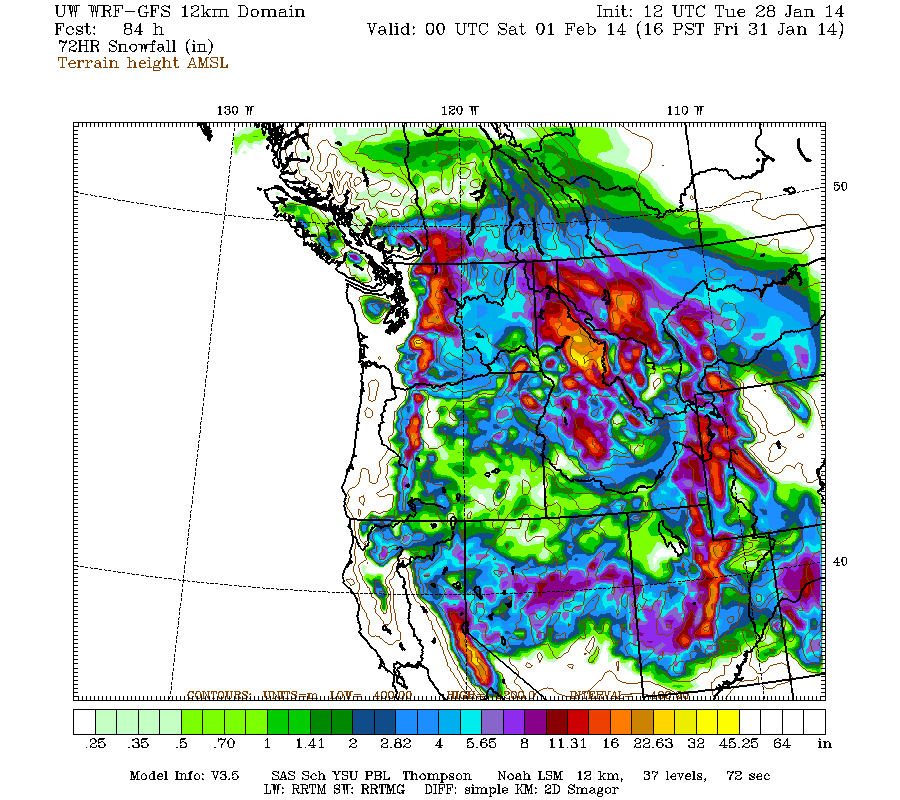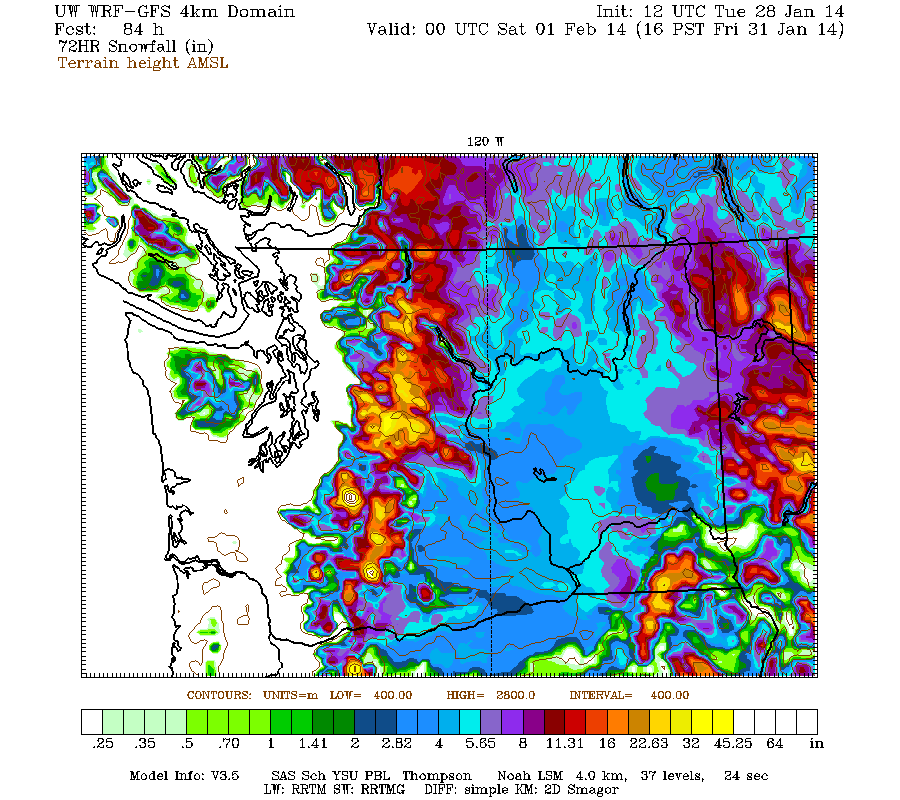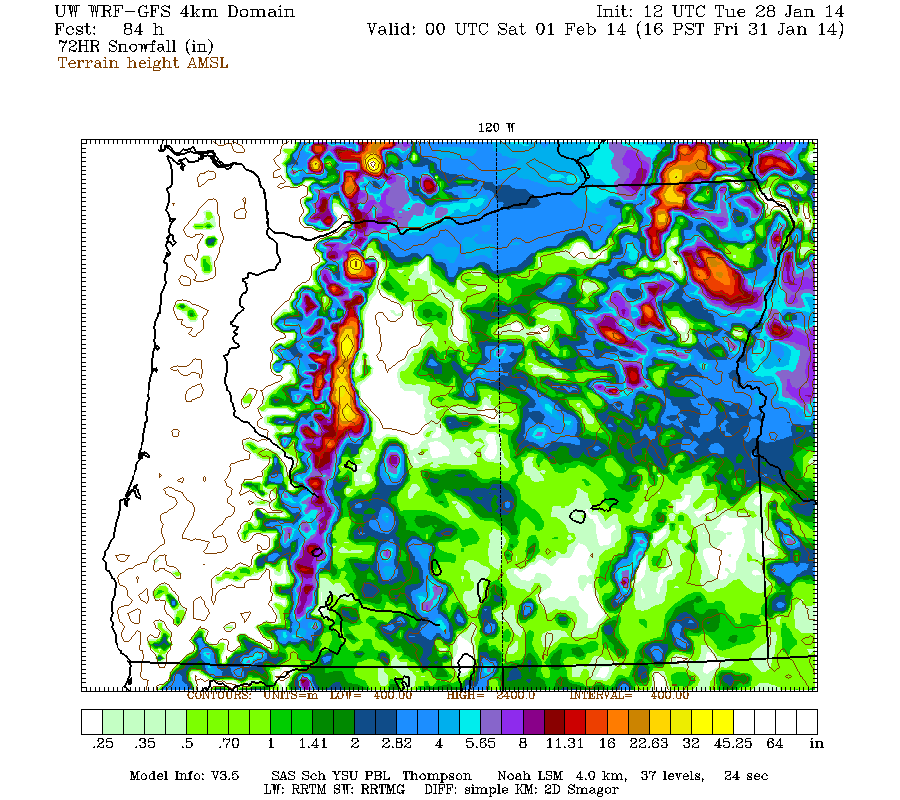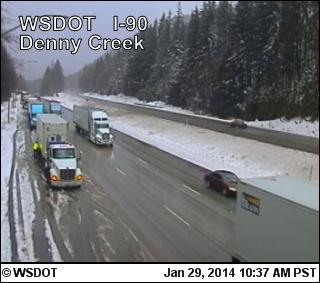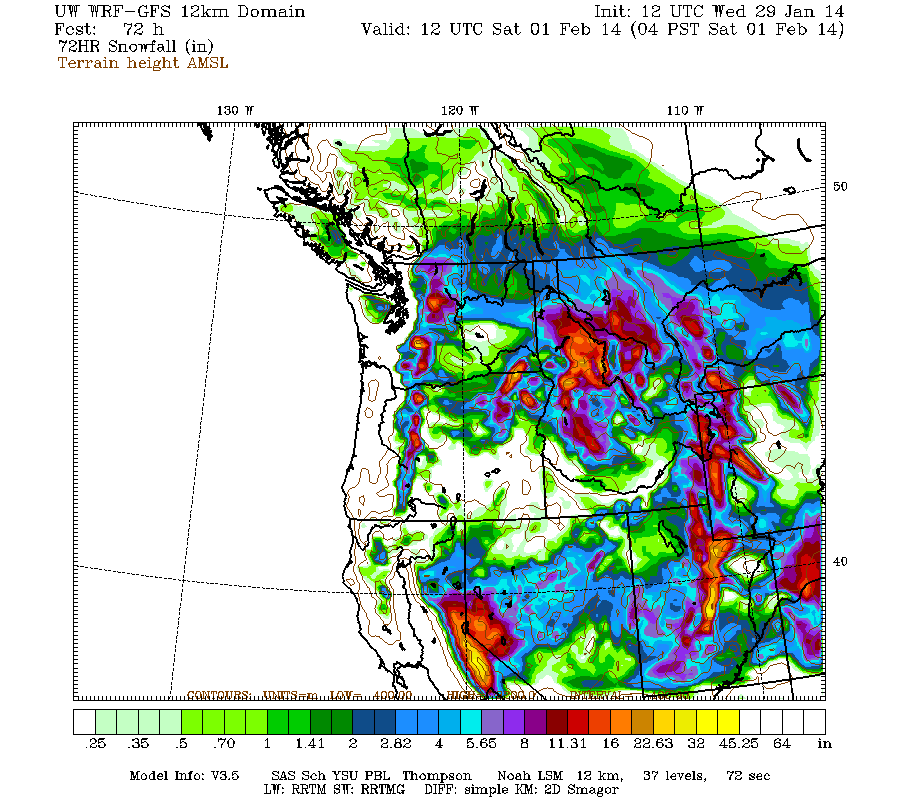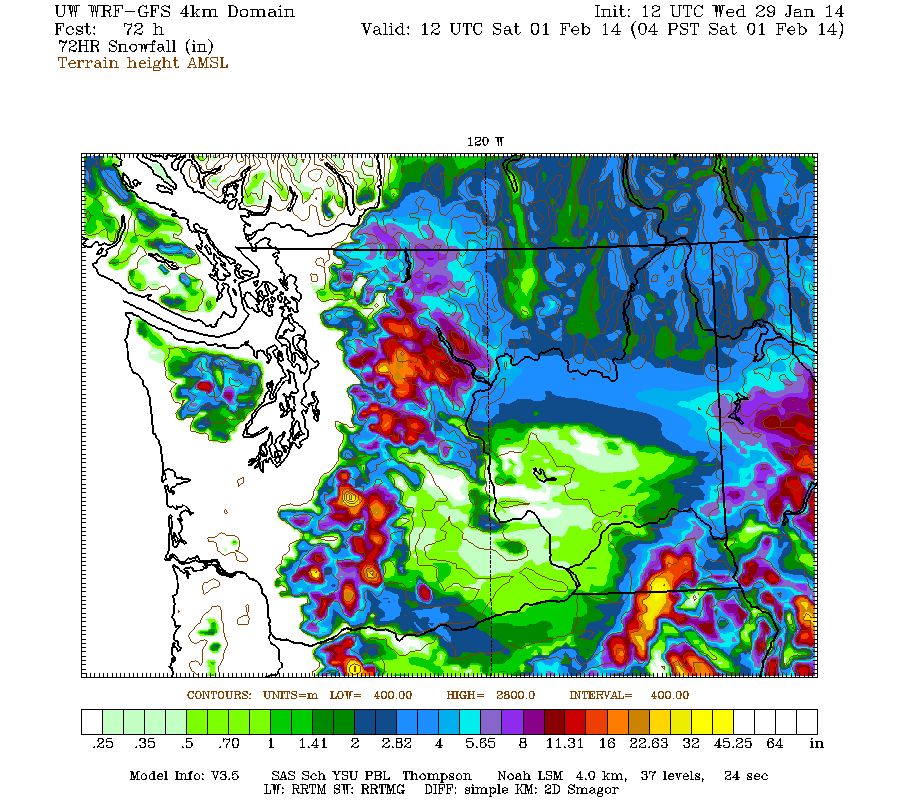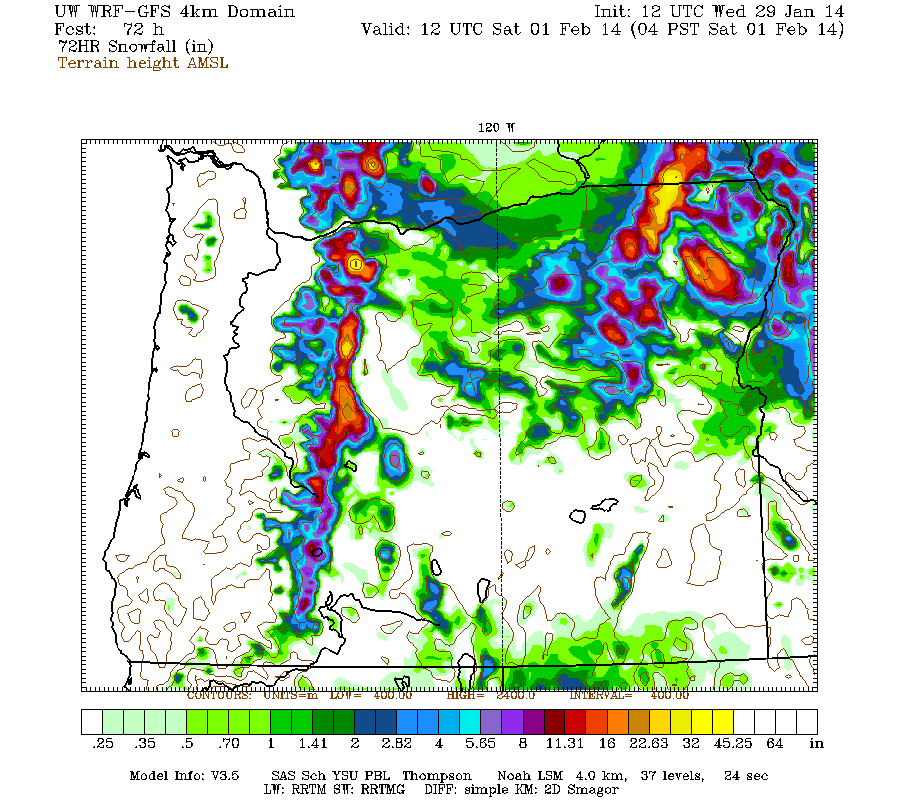- Posts: 635
- Thank you received: 0
Another major storm brings 2-5 ft snow Jan28-Feb1!
- Amar Andalkar
- [andalkar]
-
 Topic Author
Topic Author
- Offline
- Premium Member
-

Another major storm cycle to bring 2-5 ft of snow this week, to the Pacific Northwest and to California?!
See also earlier thread: First major storm cycle of the 2013-14 season brings 4-8 ft of snow (January 7-14)
During the past few days, weather models have started predicting another major change in the weather pattern over the West Coast during the rest of this week. The anomalously strong and persistent ridge of high pressure which has lingered just off the West Coast for much of the last 4 months will break down at least for a while, allowing sustained westerly flow once again and the second major winter storm cycle of the 2013-14 season for the Northwest -- and the first for California, where the current snowpack situation is far more dire than the Northwest.
The NWS's GFS model and the high-resolution UW WRF-GFS model which is built on it are showing up to 3-6" of precipitation over the next 3 days, with snow levels dropping into the 2000-4000 ft range. Snowfall during the next 3 days through 4pm Friday is predicted to be 2-5 ft over the west slopes and volcanic peaks of the Washington and Oregon Cascades, plus portions of the high Sierra Nevada:
Higher resolution version of that, zoomed in on WA and OR:
Maximum amounts of 4-5 ft (marked by white inside yellow) are shown on Mounts Rainier and Adams, with 3-4 ft for Mounts Hood, Jefferson, and the Three Sisters in Oregon.
Details beyond the 3-4 day period are still murky and uncertain, best to wait a few more days and see how this system plays out. But there is no indication as of now of the ridge rebuilding strongly again immediately after this system.
Please Log in or Create an account to join the conversation.
- spresho
- [spresho]
-

- Offline
- New Member
-

- Posts: 32
- Thank you received: 0
Please Log in or Create an account to join the conversation.
- Charlie Hagedorn
- [trumpetsailor]
-

- Offline
- Elite Member
-

- Posts: 913
- Thank you received: 1
I'm not colorblind, but one of my advisors is, so I'm used to plotting in blue/yellow. The scales on these plots are fairly colorblind-friendly, but the topography's not, making it impossible to follow the gradient. In some of these plots, the Olympics are a different red/green than the Cascades.
Have you seen the browser Daltonizer tools? There's a Chrome extension (didn't try it), and some javascript bookmarklets that Daltonize TAY/these plots.
The latter one should work on most browsers, and has a big effect on the color spectrum displayed. Perhaps one of the tools might work for you? Do they work?
The simulators can be enlightening for the non-colorblind; they changed my understanding of colorblindness the first time I used them on my own plots. I find that a plot that's clear for my advisor is clearer for everyone else, too.
To get a sense of what spresho is talking about, try the "Protanope" simulator on the bookmarklet page against the TAY plots. It's an impressive effect in this case.
Please Log in or Create an account to join the conversation.
- avajane
- [avajane]
-

- Offline
- Premium Member
-

- Posts: 638
- Thank you received: 1
Please Log in or Create an account to join the conversation.
- Amar Andalkar
- [andalkar]
-
 Topic Author
Topic Author
- Offline
- Premium Member
-

- Posts: 635
- Thank you received: 0
A day later, and 2 subsequent runs of the UW WRF-GFS model at 12-hour intervals continue to show similar predictions for large snowfall amounts. Consistency between subsequent model runs typically tends to indicate that the predictions are more likely to actually verify.
The first round of significant precipitation moved in on Tuesday evening as predicted. As of Wednesday morning, about 1-1.5" of precip has already fallen along the west slopes and crest of the Washington Cascades from about Stevens Pass southward, with less in the Olympics (< 1") and far less in the North Cascades (generally < 0.4"). Much more has fallen farther south, with 2-3" on Mount Saint Helens, Hood, and other parts of the northern Oregon Cascades.
Snow levels were about 6-7000 ft during this time, so about 1-2 ft of new snow has already fallen at elevations above that. A cold front moving southward Wednesday morning is rapidly lowering snow levels to 3-4000 ft, with snowfall already extending far below Snoqualmie Pass to under 1800 ft on the west approaches due to easterly pass flow.
[size=small]A few inches of snow already fallen at MP 46.8, 1800 ft.[/size]
Snow levels will eventually drop to 2000 ft overnight into Thursday morning throughout the Washington and northern Oregon Cascades. Snowfall during the next 3 days through 4am Saturday is predicted to be an additional 2-4 ft over the west slopes and volcanic peaks of the Washington and Oregon Cascades, plus portions of the high Sierra Nevada:
One significant change compared to 24 hours ago is that the splitting flow is now shown to be missing northernmost California almost completely, leaving the California Cascades including Mount Shasta and Lassen Peak with only a few inches. This is not good at all, for although the snowpack situation in the Sierra is dire (10-20% of normal), it is even worse than that in the Trinity Alps and California Cascades (about 0-5% of normal). On Shasta and Lassen there is almost no snow at all, easily an all-time record low for this date over the period of record which extends back to 1930 on both mountains.
Higher resolution version of that, zoomed in on WA and OR:
Maximum amounts of 3-4 ft (marked by bright yellow) are shown on Mounts Rainier, Saint Helens, Hood, and Jefferson, plus the Blue Mountains along the eastern WA-OR border and the crest of the Sierra Nevada south of Tahoe near Yosemite.
This loop shows how the model predictions for snowfall during the 3-day period through 4am Saturday have evolved between 10 subsequent runs over the last 5 days, known in the jargon as D(model)/D(t). Lots of changes in the details especially a few days ago, but fairly consistent in the overall picture:
www.atmos.washington.edu/~ovens/wxloop.c...2+v2014020112///+-st
Details beyond the 3-4 day period still remain uncertain, but little additional snowfall is expected after Friday throughout the weekend. The ridge of high pressure is likely to rebuild northward during the weekend and early next week, but well offshore in the Pacific, leaving the Northwest under a mixed bag of partly cloudy weather while California and southern Oregon become mostly sunny once again.
Please Log in or Create an account to join the conversation.
- spresho
- [spresho]
-

- Offline
- New Member
-

- Posts: 32
- Thank you received: 0
For sure.
I'm not colorblind, but one of my advisors is, so I'm used to plotting in blue/yellow. The scales on these plots are fairly colorblind-friendly, but the topography's not, making it impossible to follow the gradient. In some of these plots, the Olympics are a different red/green than the Cascades.
Have you seen the browser Daltonizer tools? There's a Chrome extension (didn't try it), and some javascript bookmarklets that Daltonize TAY/these plots.
The latter one should work on most browsers, and has a big effect on the color spectrum displayed. Perhaps one of the tools might work for you? Do they work?
The simulators can be enlightening for the non-colorblind; they changed my understanding of colorblindness the first time I used them on my own plots. I find that a plot that's clear for my advisor is clearer for everyone else, too.
To get a sense of what spresho is talking about, try the "Protanope" simulator on the bookmarklet page against the TAY plots. It's an impressive effect in this case.
I am familiar with the info on that Daltonize site, but I have never heard of the bookmarklets. Thanks to you for pointing them out. I already have ruled out the tritanope, and am leaning toward the deuteranope. I will need to play with them a bit more to figure out between the deuter and the proto before I settle on one.
My sincerest apologies to Amar for hijacking his good news thread. Your analysis is greatly appreciated.
Please Log in or Create an account to join the conversation.
- Amar Andalkar
- [andalkar]
-
 Topic Author
Topic Author
- Offline
- Premium Member
-

- Posts: 635
- Thank you received: 0
My sincerest apologies to Amar for hijacking his good news thread. Your analysis is greatly appreciated.
No problem, it's OK, thanks.
Storm Summary: (belated post, partially written February 1, but not completed and posted at that time)
The model predictions for Washington and northern Oregon largely verified, although the largest snowfall amounts were received at elevations above the measurement sites. Snowfall amounts were up to 2-3 ft from Alpental and Snoqualmie Pass south to Mount Hood in Oregon, with much smaller amounts of about 1 ft or less in the Olympics, North Cascades, and farther south in the Oregon Cascades. Maximum precipitation amounts of 5-7" were received on both Mounts Saint Helens and Hood, but much of that fell during the early part of the storm when snow levels were 7000-8000 ft -- snowfall amounts of 4-5 ft were likely received on both mountains above those elevations.
The very high snowfall amounts of 3-5 ft predicted for the southern Sierra Nevada do not appear to have verified at any measurement sites, with about 1-2 ft in the high Sierra Nevada especially from south Lake Tahoe to Mammoth Mountain, but unfortunately the very low snowfall amounts (near zero) predicted for northernmost California including the California Cascades did verify: Mount Shasta and Lassen Peak received only a few inches once again, and snowdepths remain near-zero (less than 1 ft) on both mountains.
Table of total snowfall and precip: (some amounts may be approximate) for the 4 day period from January 28 through Saturday, February 1, along with the increase in snowdepth from January 28 up to the maximum depth reached during this storm cycle (mostly on January 31 in WA, February 1 in OR)
Total Snowdepth Total
Measurement Site Elevation Snowfall Jan28 >>> Max Precip Notes
======= Washington =======
Hurricane Ridge 5250 ft 0.8 ft 25" >>> 33" 1.1"
Mt Baker Ski Area 4200 ft 0.7 ft 79" >>> 86" ? (snowdepth & precip flaky)
Mt Baker, MF Nooksack 4970 ft 1 ft 72" >>> 81" 1.5" (NW side of Mt Baker)
Mt Baker, Marten Ridge 3520 ft 0.5 ft 51" >>> 57" 2" (E side of Mt Baker)
Mt Baker, Elbow Lake 3040 ft 0.5 ft 28" >>> 34" 1.5" (SW side of Mt Baker)
Brown Top SNOTEL 5830 ft 0.5 ft 79" >>> 85" 0.7"
Washington Pass 5450 ft 1 ft 45" >>> 56" ? (precip not working)
Stevens Pass 5250 ft 1.5 ft 72" >>> 86" --
Stevens Pass 3950 ft 1.5 ft 48" >>> 62" 2"
Berne Snow Camp 2700 ft 1 ft 6" >>> 17" 1.5"
Lake Wenatchee 1930 ft 1 ft 0" >>> 10" 1"
Mission Ridge 5160 ft 0.5 ft 18" >>> 22" 0.6"
Top of Alpental 5470 ft 3 ft 84" >>> 107" -- (snowdepth uncertain?)
Alpental Base 3100 ft 2 ft 35" >>> 58" 3.5"
Snoqualmie Pass 3000 ft 1.5 ft 27" >>> 45" 3.8"
Crystal Mtn, Green Valley 6230 ft 1 ft 61" >>> 70" --
Crystal Mtn Base 4570 ft 0.5 ft 22" >>> 27" 1.8"
Mt Rainier, Sunrise 6400 ft 1 ft 34" >>> 43" --
Mt Rainier, Paradise 5400 ft 2 ft 85" >>> 107" 3.5"
Mt Rainier, Longmire 2700 ft 0.8 ft 3" >>> 9" 1"
White Pass Ski Area (top) 5800 ft 1.5 ft 74" >>> 88" 2.5"
Mt Adams, Potato Hill 4510 ft 1 ft 36" >>> 43" 2" (N side of Mt Adams)
Mt St Helens, Swift Creek 4440 ft 1.5 ft 30" >>> 43" 5.5" (S side of St Helens)
Mt St Helens, Sheep Canyon 3990 ft 1 ft 23" >>> 34" 4.5" (W side of St Helens)
Mt St Helens, June Lake 3440 ft 1.5 ft 18" >>> 32" 6" (SE side of St Helens)
========= Oregon =========
Blazed Alder SNOTEL 3650 ft 2 ft 13" >>> 29" 6" (NW of Mt Hood)
Mt Hood, Red Hill SNOTEL 4410 ft 1.5 ft 27" >>> 38" 5" (N side of Mt Hood)
Mt Hood, Timberline 5880 ft 2 ft 60" >>> 75" 7.2"
Mt Hood, Test Site SNOTEL 5370 ft 2 ft 49" >>> 67" 5" (just S of Timberline)
Mt Hood, Ski Bowl 5010 ft 1 ft 15" >>> 22" 4" (S of Mt Hood)
Mt Hood, Meadows 5380 ft 1.5 ft 47" >>> 58" 5"
Mt Hood, Mud Ridge SNOTEL 4070 ft 0.5 ft 18" >>> 21" 3" (S of Mt Hood)
Santiam Pass (Hogg Pass) 4790 ft 0.5 ft 13" >>> 16" 1.2"
Bear Grass SNOTEL 4720 ft 1 ft 21" >>> 27" 4.5" (W of Mt Washington)
McKenzie Pass SNOTEL 4770 ft 0.5 ft 31" >>> 33" 4.5" (near Obsidian Trailhead)
Three Creeks Meadow SNOTEL 5690 ft 0.3 ft? 13" >>> 13" 1.5" (E of Three Sisters)
Mt Bachelor, West Village 6300 ft 0.5 ft 50" >>> 54" --
Irish Taylor SNOTEL 5540 ft 0.5 ft 33" >>> 36" 3" (SW of Mt Bachelor)
Willamette Pass, Cascade Smt 5100 ft 0.5 ft 25" >>> 28" 3.5"
Diamond Peak, Summit Lake 5610 ft 0.3 ft? 26" >>> 26" 1.5" (S side of Diamond Peak)
Crater Lake, Park HQ 6470 ft 0.2 ft 16" >>> 15" 3.1"
This storm cycle was followed by an extended period of partly cloudy weather with snow showers in northern Oregon over the first 3 days of February, which brought an additional 1-1.5 ft of snow on Mounts Hood and Bachelor, with a few inches south to Crater Lake. Then a modified Arctic blast dove south into Washington and northern Oregon, with temperatures plunging below zero °F at most NWAC telemetry sites on February 5 and 6 . This was immediately followed by the next major storm system moving ashore in Oregon and northern California on the morning of February 6, with several feet of additional snowfall expected in those areas over the next several days -- especially welcome news in northern California which has suffered by far the worst drought of any mountain region in the US thus far this winter.
Please Log in or Create an account to join the conversation.

